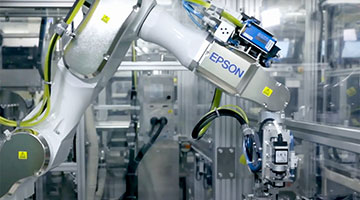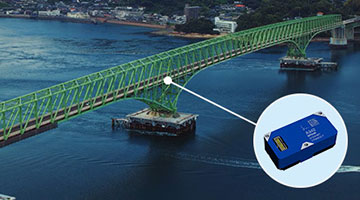Fulfilling Social Responsibility with Our Technologies
Printer (Inkjet) Technologies
There is an urgent need to respond to environmental issues, most notably climate change and resource depletion. Meanwhile, changing lifestyles have increased the need for short-run production. Addressing these societal issues requires production process innovation. Epson is working to realize social sustainability, achieving higher productivity while reducing environmental impact by innovating its customers' printing and production processes, including through digitalization.
High-speed linehead inkjet multifunction printers, because they do not use heat, demonstrate energy-saving performance than office laser printers. Epson's heat-free linehead inkjet multifunction printers print even dense patterns at consistent high-speeds and in high volumes. Through this technology, we will provide our customers with value by reducing their environmental impacts and improving their operational and production efficiency.
High-capacity ink tanks and packs also reduce the amount of consumables and packaging used.
In the world of commercial and industrial printing, there is strong public pressure on printing firms to accommodate short-run production and customization and to use environmentally considerate technology. As these needs mount, printing firms are shifting away from plate-based analog printing toward digital printing. Epson is driving this digital shift with inkjet technology that makes it possible to flexibly accommodate demand fluctuations and rapid turnarounds, shrink dead stock and disposal losses, reduce waste ink and water use by eliminating the need to clean printing plates, and limit the amount of space needed for storing work in process.
Learn how Epson is minimizing customer environment impact.
We are also developing and offering solutions and options based on our core devices. For example, in many cases, our customers often rely on the experience and intuition of specific operators to accurately match colors. To make color matching easier, Epson launched a colorimeter that measures and quantifies colors, including spot colors. The measured color data can be used in Adobe® Illustrator® via Epson Cloud Solution PORT, enabling accurate and efficient remote color management. In this way, Epson continues to refine its inkjet platform by creating its own options and solutions that leverage its core devices.
Instead of heating the ink, Epson's Micro Piezo printheads eject tiny ink droplets via the mechanical action of piezoelectric actuators. The absence of heating means that our printheads can also be used to deposit materials other than ink, such as bio-materials and metallic inks. We are expanding the range of uses for our inkjet technology beyond our own printers by providing printheads to partners and by collaborating and engaging in open innovation. In this way, we are contributing to the resolution of societal issues together with our partners.
Learn about printer (inkjet) technologies.
Projector Technologies
Even students in the back of the classroom can clearly see the content. Classrooms are one place where we can demonstrate the value of large projected images. We are thus focusing our efforts on providing products and services for education. In 2006, we developed the world's first dust-proof projectors for use in dusty and sandy regions.1 Epson seeks to use ICT to enhance learning and improve the quality of education, and in so doing has earned a strong reputation in the education field by providing affordable projectors and models equipped with electronic blackboard functions.
We aim to provide a smooth and stress-free communication environment, one that combines real-world and remote communication. Projectors are one way we can do this. A projector that combines 4K-equivalent resolution with an ultra-short-throw lens can project sharp, nearly life-sized images of people at remote locations, creating the illusion that everyone is in the same space.
Moving ahead, we will fulfill our social responsibility by continuing to apply Epson ICT technology in ways that enhance learning and by helping to improve the learning environment around the world.
1 First according to research at that time, in 2006

Robot Technologies
Epson has developed technologies and devices in diverse businesses. Among them are image processing and sensing technologies. By combining these technologies with the automation expertise we have cultivated at our own production sites, we are able to provide small, lightweight, slim, power-saving robots that boast unrivaled speed and precision yet are easy to use.
It also requires the design and construction of processes based on manufacturing know-how. While robots are capable of accurate work, they are not adept at grabbing and plugging in flimsy cables into connectors whose installation position may vary. This is why know-how in designing and building processes is essential. We solved this problem by equipping robots with image processing to detect connector position and an Epson force sensor that can sense minute forces.
We help our customers build their production systems by leveraging the automation know-how we have accumulated in our own precision-assembly factories. We also provide fast, flexible, and consistent services through our global sales and production sites, which have been strategically located in response to geopolitical risks.

Learn about robot technologies.
Wearable Technologies
The demand for luxury goods that cater to diverse values, hobbies, and tastes is growing.
Epson will provide attractive and high-quality products with our efficient, compact, and precision technologies and our artisanal skills, to enrich the diverse lifestyles of our customers.

Microdevice Technologies
Epson is helping to resolve societal issues by combining the precision quartz crystal and low-power semiconductor technologies that originated in our watch business.
We employ these core technologies in our real-time clock modules to increase their power efficiency, accuracy, and precision. These modules are used in IoT terminals and other systems that need to be small and energy efficient. We thus support the development of products that have a smaller environmental impact, ones that consume less power and can run on smaller batteries without compromising operating time.
Epson also supports civil infrastructure by providing microdevices that meet the societal demands of high-speed, high-capacity communications, IoT, and mobility. For example, our sensors detect subtle vibrations in bridges, dams, and flood control gates, helping to identify abnormalities caused by aging. This enables efficient maintenance of wide-ranging infrastructure with limited personnel and reduces the need for work in hazardous environments.
Furthermore, Epson's inertial measurement units (IMUs) support stable autonomous operation of transport trucks, drones, and warehouse robots, contributing to improved logistics efficiency and helping address labor shortages in the logistics industry.
In these ways, Epson fulfills its social responsibility by leveraging its technological strengths to promote environmental conservation, support a safer and more secure future, and contribute to the realization of a smarter society.



